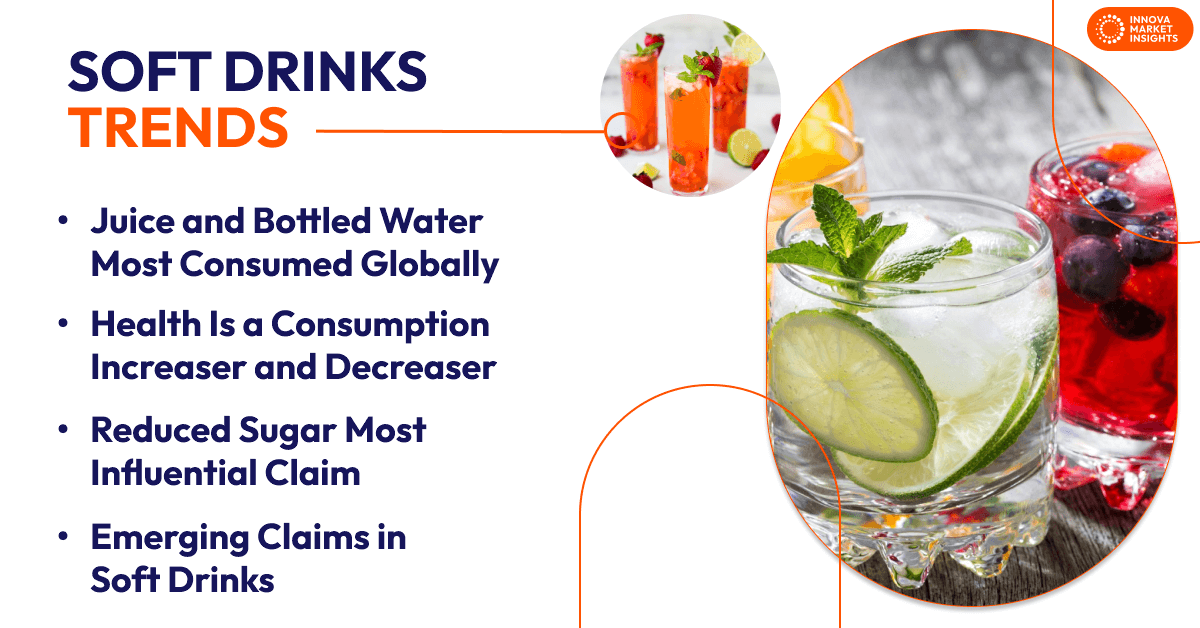Consumers are prioritizing their desire to live and feel well, and this is driving change in the soft drinks category. These consumers may be reducing consumption of soft drinks they view as “empty calories.” Instead, consumers are replacing these beverages with low- or no-sugar alternatives or choosing mineral fortified drinks.
Juice and Bottled Water Most Consumed Globally
Juice and bottled water are among the top ten most commonly consumed global soft drinks. Bottled water showed the most growth in consumption among soft drinks over the past year, with unflavored water and functional water being consumed the most. Key consumption trends for soft drinks such as water are health and quenching thirst.
Health Is a Consumption Increaser and Decreaser
Conscious consumption and health are top reasons for soft drinks consumers to increase their consumption of bottled water, juice, and iced tea. Simultaneously, health is a leading reason for decreasing soft drinks consumption of carbonated sodas and energy drinks, according to 59% of consumers globally. Nearly one-third of consumers also mention a change in budget as a reason for decreasing their intake of iced coffee, iced tea, or carbonated soda.

Reduced Sugar Most Influential Claim
Reduced sugar ranks among the most influential claims for consumers of carbonated soft drinks, sparkling juice, iced tea, juices, iced coffee, and energy drinks. Other soft drinks claim trends include consumer demand for natural and real ingredients. This claim trend is particularly influential for over 20% of global iced coffee and tea drinkers. ‘Less sugar’ claims in soft drinks are important for sparkling juice, non-sparkling juice, and energy drink consumers.
Emerging Claims in Soft Drinks
With the functional beverage segment growing, plant-based, immune health, prebiotic, and high fiber claims are emerging in the soft drink category. North America and Australasia are the main growth drivers in this area.
Fruit Flavors Dominate
Growing flavor trends in soft drinks include tea, spice, and flower flavors. Fruit flavors remain prominent, but their use in soft drinks is declining. This decline could be attributed to consumers being cautious about drinking soft drinks they view as having “empty calories.” Another soft drinks flavor trend is that 23% of iced tea consumers and nearly 20% of iced coffee and carbonate consumers find it important that their beverages are made without artificial flavors or colors.
Soft Drinks Ingredient Trends
An ingredient trend on the rise in the soft drinks category is the use of sweeteners and functional ingredients. Sweetener trends, such as the addition of sucralose and acesulfame-K, saw a +6% growth in new soft drinks launches compared to five years ago. Together with the sweetener erythritol, these three sweeteners are the fastest-growing sweeteners in soft drinks. Nutraceutical and functional ingredients trends, such as using fatty acids and botanical extracts, saw a +5% growth over the same period.
What’s Next?
Innova predicts several category developments in soft drinks. The developments include soft drinks types, flavors, and consumer targets. Companies will introduce more flavored bottled water, iced tea, and iced coffee to capture their share of projected sales growth over the next few years. Flavor innovation across the different types of soft drinks is likely to include more fruit options, including berries, exotic fruits, and mixed flavors that may feature spices or flowers. Innova also anticipates more pop culture collaborations as key manufacturers pursue strategic efforts to target generational groups important for future category growth.